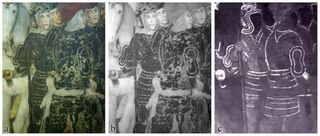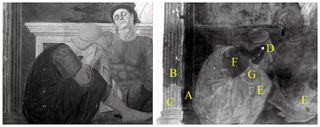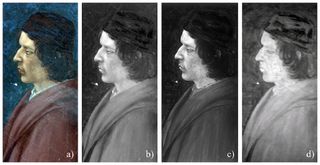Gallery: Hidden Gems in Renaissance Art
Theodelinda's Frescoes

Part of a fresco by the Zavattaris in the Theodelinda’s Chapel near Milan, Italy. The artworks, executed between 1440 and 1446 are extremely rich and complex, featuring different fresco techniques, gold and silver decorations and reliefs. Color photography (a), and imaging in the NIR (b), compared to the TQR image (c).
"The Resurrection"

Piero della Francesca's "The Resurrection" was painted around 1460. Under new imaging techniques, researchers can see differences in pigments and painting style not visible to the naked eye.
Unseen Detail

“The Resurrection” by Piero della Francesca (detail): NIR image (left) and TQR image (right). A Original area; B and C painted integration; D Restoration plaster; E Green Earth pigment; F and G pigments with similar behavior in the visible and different reflectivity in infrared.
Resurrection Details

In "The Resurrection," TQR techniques show retouching in (A), odd spots on the shield in (B), and different painting techniques in (C) around the soldier's sword. In area (D), the background is clearer using infrared reflection techniques, and pigments reflect differently in area E versus visible light.
Fresco Copy

A fresco model, copied from Italian Renaissance painter Domenico Ghirlandaio in about 1930. Researchers used this copy to test their new imaging technique. Certain details popped, such as drawing traces in the face and finishing touches on the mouth.
TQR Setup

The setup of the TQR system. Two halogen lamps shine onto the fresco while a camera record infrared light that reflects off of the art.
Sign up for the Live Science daily newsletter now
Get the world’s most fascinating discoveries delivered straight to your inbox.

Stephanie Pappas is a contributing writer for Live Science, covering topics ranging from geoscience to archaeology to the human brain and behavior. She was previously a senior writer for Live Science but is now a freelancer based in Denver, Colorado, and regularly contributes to Scientific American and The Monitor, the monthly magazine of the American Psychological Association. Stephanie received a bachelor's degree in psychology from the University of South Carolina and a graduate certificate in science communication from the University of California, Santa Cruz.
Most Popular

